Table of contents
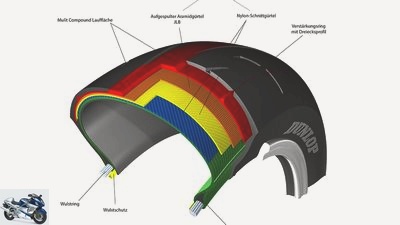
M. Jahn, R. Gluck, Dunlop
accesories
tire
PS knowledge: tire dictionary
PS knowledge tire lexicon
The ABC of tires
Content of
Tires aren’t just black and round. They guarantee driving fun and safety. So we should know more about them than the brand and its price. PS gives important tips.
Robert luck
04/22/2014
Age / retention
The older a tire, the less grip it offers. If tires are stored correctly, i.e. dark, dry, not above 25 degrees and without mechanical pressure, they can be used for up to six years after production, according to Bridgestone experts. The age of the tire can be seen on the production date (see DOT number).
Buy complete article

PS knowledge tire lexicon
The ABC of tires
2 pages) as PDF
€ 2.00
Buy now
Balancing
Tires and rims have manufacturing tolerances. Usually the lightest part of a tire is marked with a colored dot. The balancing weights equalize the masses of the wheel / tire combination and prevent unpleasant vibrations.
Types: diagonal / radial tires (Source: Continental)
The bias tire is the “classic” among motorcycle tires. Its carcass layers (see also carcass) are arranged diagonally to the direction of rotation of the wheels. Its advantages lie in the simple structure and in the flank stability, which is particularly advantageous in terrain (puncture protection). Due to the design, diagonal tires can usually be used (example old V250 identification) up to a maximum of 240 km / h. Modern radial tires have a carcass angle of around 90 degrees and a belt angle of 0 to 25 degrees to the direction of travel. The belt under the tread ensures stability and, thanks to the significantly lower centrifugal force deformation, allows significantly higher speeds. Due to the lower material thickness in the flank area (sidewall) of the tire, it heats up less, and the maximum speed resistance is also increased. Radial tires can withstand maximum speeds of over 300 km / h.
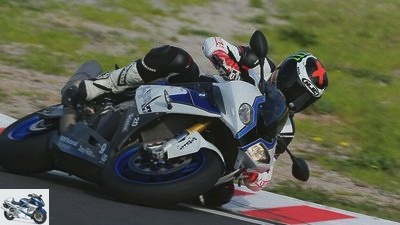
Jahn
Loss of grip on the front wheel as here leads to the so-called lowsider. The right grip balance between the front and rear wheel is very important, especially in wet conditions.
DOT number
The DOT (Department of Transportation) number shows the production date of each tire. Tires manufactured after 1999 have four digits after the DOT. The first two indicate the week of production, the last two the year of manufacture. “DOT 4513” means the 45th calendar week of 2013.
Dual compound
A dual compound tire has several rubber compounds on the tread. The middle compound strip is tough to enable a long service life, the rubber strips on the side of the tire are softer in order to create a lot of grip in an inclined position. At the moment, three treads (outside / middle / outside) are state of the art.
Run-in / warm-up
A new tire has a smooth surface because of its manufacturing process. This must be roughened by running in at a moderate pace. Manufacturers indicate a running-in time of up to 200 kilometers. Especially in an inclined position, new pelts should not be subjected to maximum load immediately. This also applies when warming up a fitted tire that has already been run into. Don’t overdo it for the first few miles.
Approvals / clearance certificate
Which tire can be used on which motorcycle? If there is no entry in the registration certificate I (vehicle license) under number 22, each tire may be fitted with the sizes defined in fields 15.1 and 15.2. However, PS recommends only fitting tires that have a tire approval or clearance certificate from the manufacturer. These can be found on the tire manufacturers’ websites.
Speed index
The maximum permissible speed of a tire is written in letters on the sidewall, directly behind the load index, see above in the picture (73W). A W without brackets stands for a maximum of 270 km / h, the W in brackets for over 270 km / h. You can find a complete list of the speed index at www.conti-moto.de under “Tire tips / FAQs”.
Rubber compounds
In addition to the tire contact area, the rubber compound is responsible for adhesion. Many manufacturers now offer tires with different compounds within the tread (see dual compound). Different compounds for different temperatures and motorcycle types are also used in racing tires. Which mixture (soft / medium / hard) is suitable for which conditions (cool / warm / hot) and for which racing motorcycle should be asked by the respective racing service of the manufacturer.
liability (Source: Michelin)
Adhesion (grip) has to be divided into two mechanisms – the interlocking effect and the molecular adhesion. The interlocking effect is created by the penetration of the road roughness into the rubber of the tread profile. The molecular adhesion results from the molecular interactions in the contact area (tire contact area) between rubber and road. These connections form, break apart, and re-form. The molecular chains of the rubber are cyclically stretched and broken. In doing so, viscoelastic work is performed, namely the friction work of the molecular segments clamped in the corset. This work increases the connection energy (and thus the adhesion) by a factor of 100 to 1000, depending on the temperature on the road surface and the speed.
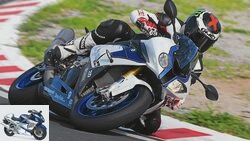
tire
MOTORRAD tire test 2013
6 sports tires of size 120/70 ZR 17, 190/55 ZR 17 in the test
read more
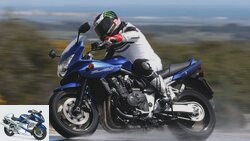
tire
Tire test 2013: 6 touring tires 120/70 ZR 17, 180/55 ZR 17
Touring tire test 2013
read more
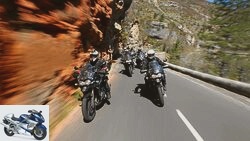
tire
Enduro tires in the 2013 tire test
Six pairs of enduro tires of size 110/80 R19, 150/70 R17
read more
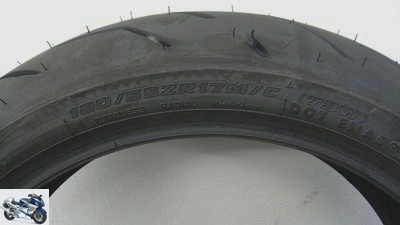
happiness
Tire identification and DOT number are on the sidewall of each tire.
carcass
The carcass is the substructure and the supporting structure of a tire. With diagonal tires, this often consists of several layers of rayon or nylon fabric. For radial tires, steel or armid belt layers are used, depending on the manufacturer. The construction of the carcass has a decisive influence on the characteristics of the tire such as handling and stability.
Running direction
An arrow on the sidewall of the tire indicates the direction of use (in the direction of travel). This must be strictly adhered to.
Air pressure indication and change
Information on the correct air pressure can be found in the owner’s manual for each motorcycle. Lowering the air pressure increases tire wear, but increases the temperature of the tire and thus its grip on cool days. If the air pressure is too low, the steering accuracy and stability of a tire decrease considerably, and there is a risk of falling.
Minimum tread depth
According to §36 StVZO, the legal minimum tread depth for motorcycle tires is 1.6 millimeters. If this is reached at a point on a main tread groove near the TWI (“Treadwear Indicator” – this is located in the tread and is displayed on the side wall), the tire is worn out.
Assembly
This should be left to professionals, as incorrect installation can damage the tire.
profile
The tire tread is mainly used for optimal water displacement when it rains.
Video about the tire special:
\ n<div class = \&# 34; v-A_-custom-html v-A_-custom-html – video \ “>\ n<iframe width = \&# 34; 578 \&# 34; height = \&# 34; 325 \&# 34; src = \&# 34; // www.youtube.com/embed/WKgTevwmmLk? List = UUhWBtAacaOja7iK_AHVWXBg \&# 34; frameborder = \&# 34; 0 \&# 34; allowfullscreen></ iframe>\ n</ div>\ n</ div>\ n&# 34;,&# 34; consentGroup&# 34;: null}”>
Tire contact area (Latsch)
It describes the part of the tire tread that is in contact with the asphalt while driving. This area corresponds roughly to the size of a matchbox per tire, a little less at the front and a little more at the back.
Tire identification
It is located on the side wall (see picture above left) and consists of the tire width in millimeters (180), the cross-section ratio of height to width in percent (55), the design ZR (radial), the rim diameter in inches (17), the usage designation M / C (motorcycle), the load index (73), the speed index (W) and the tubeless information (TL).
Tire repair
Repairs to radial tires are generally not recommended, and recutting the profile is generally prohibited.
Tubeless tires
They seal themselves against the rim by themselves. Tubular tires are mainly used off-road.
Load index
It describes the maximum load capacity of a tire. You can find an overview of the payloads, for example, at www.conti-moto.de under “Tire tips / FAQs”.
Transferability of test results
Tire test results can only be transferred to other vehicles to a limited extent. The adhesion rating of a tire, for example, can be transferred, but handling and steering precision are not, as these ratings are also heavily influenced by the vehicle geometry.
Valve cap
A must on every valve, as it also seals the valve and protects it from damage caused by dirt.
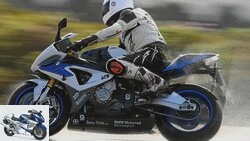
tire
The 2013 PS sports tire test
6 sports tires in the horsepower test
read more
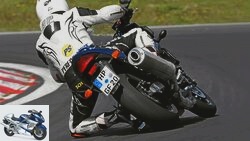
tire
HP comparison test touring tires
Touring rubbers delight PS testers
read more
Related articles
-
Fox accesories tire Understand tire labels What do the numbers and letters on a tire mean?? Understand tire labels A tire shows a lot of information…
-
Jahn accesories tire The 2013 PS sports tire test The 2013 PS sports tire test 6 sports tires in the horsepower test Content of Sports tires are our…
-
What is the best motorcycle sports tire of 2015?
mps photo studio 11 pictures mps photo studio 1/11 The RS 10 is a very decent skin with many strengths and without significant weaknesses. Accordingly,…
-
Dunlop 14th pictures Dunlop 1/14 The Dunlop plant is located in Montluçon, France. Dunlop 2/14 125 years after its premiere, the pneumatic tire still…
-
www.jkuenstle.de 20th pictures www.jkuenstle.de 1/20 Under adverse conditions, i.e. wet, cold or the nasty combination of these two weather situations,…
-
Tire test 2013: touring tires 120-70 ZR 17, 180-55 ZR 17
Jahn 20th pictures Jahn 1/20 Tire test 2013: 6 touring tires of the dimensions 120/70 ZR 17, 180/55 ZR 17. Jahn 2/20 The same conditions for everyone:…
-
Tire age, inflation pressure, balancing
Marcus Jahn accesories tire Tire age, inflation pressure, balancing Tire age, tire pressure, tire balancing Motorcycle tires and their problems Even when…
-
The right tire choice for a motorcycle
Markus Jahn 26th pictures MOTORCYCLE 1/26 On the way on alpine passes? That’s how it works! MOTORCYCLE 2/26 Seductive winding curves with risk. The…
-
Chassis special: Part 10 – Tire wear
archive accesories landing gear & Spring elements Chassis special: Part 10 – Tire wear Chassis special: tire wear Inferring weaknesses in the chassis…
-
Michelin tire generation comparison – Pilot Power 2CT, Road 5, Power RS
markus-jahn.com, r-photography.info, mps photo studio 9 pictures markus-jahn.com, r-photography.info, mps photo studio 1/9 Michelin tire generation…